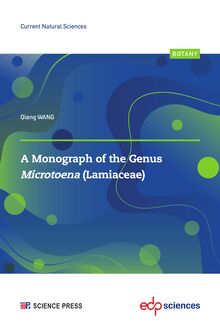A Catalogue of Asian Liverworts and Hornworts , livre ebook
428
pages
English
Ebooks
2024
Obtenez un accès à la bibliothèque pour le consulter en ligne En savoir plus
Découvre YouScribe en t'inscrivant gratuitement
Découvre YouScribe en t'inscrivant gratuitement
428
pages
English
Ebooks
2024
Obtenez un accès à la bibliothèque pour le consulter en ligne En savoir plus
Publié par
Date de parution
12 décembre 2024
Nombre de lectures
0
EAN13
9782759834402
Langue
English
Poids de l'ouvrage
6 Mo
The Asian liverworts and hornworts were first comprehensively and systematically recorded in the book. The systematic arrangement used in this book follows the structure outlined in the “Syllabus of Plant Families” (Part 3 Bryophytes and seedless Vascular Plants), published in 2009. Additionally, this book incorporates the latest research findings. Families are systematically arranged as described, with genera and species listed alphabetically. Distribution in Asia is presented by individual countries, while distribution outside Asia is categorized by continents. Each accepted species includes Latin scientific name, basionym and other synonyms. Type specimens, including the species’ original localities in Asia, are listed for both accepted names and synonyms. The distribution locations within Asia are based on the literature references.
Prologue
Preface
I. Marchntiophyta Stotler & Crand.-Stotl. ····················································· 1
Treubiopsida M. Stech, J.-P. Frahm, Hilger & W. Frey ································ 2
Haplomitriopsida Stotler & Crand.-Stotl. ················································ 3
Blasiopsida M. Stech & W. Frey ··························································· 4
Marchantiopsida Cronquist, Takht. & W. Zimm. ······································· 5
Fossombroniopsida W. Frey & Hilger ·················································· 30
Pallaviciniopsida W. Frey & M. Stech ·················································· 34
Pelliopsida W. Frey & M. Stech ························································· 36
Jungermanniopsida Stotler & Crand.-Stotl. ··········································· 37
Anthocerotophyta Rohm. ex Stotler & Crand-Stotl. ································· 359
References ························································································ 371
Index of families and genera ·································································· 412
Publié par
Date de parution
12 décembre 2024
Nombre de lectures
0
EAN13
9782759834402
Langue
English
Poids de l'ouvrage
6 Mo














